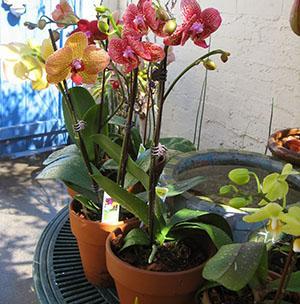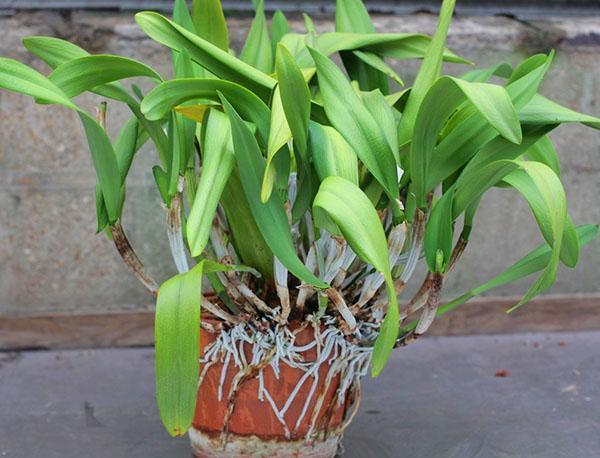Transplanting an orchid is not difficult at all
 Casual literate orchid care - the guarantee of a long life of this tropical plant and its regular flowering. But, even by properly watering the flower and maintaining the humidity of the air next to it, it is unlikely that you will succeed if you do not know how to transplant an orchid. The fact is that transferring this crop to a new pot is strikingly different from transplanting other indoor plants.
Casual literate orchid care - the guarantee of a long life of this tropical plant and its regular flowering. But, even by properly watering the flower and maintaining the humidity of the air next to it, it is unlikely that you will succeed if you do not know how to transplant an orchid. The fact is that transferring this crop to a new pot is strikingly different from transplanting other indoor plants.
Orchid care at home and its transplant are closely related to each other. If a plant is given full care, it will inevitably grow and need to be transferred to a larger container. (Phalaenopsis orchids - read about the features of care)
But determining the need for an orchid transplant is not always easy. A sign that any other indoor culture "grew" from the pot allotted to it can be considered the entanglement of the roots of the entire earthen coma. And when the roots grow through the drainage holes, the grower simply cannot hesitate.

- sprout through all kinds of pot holes;
- sucking tightly, they detach the container from the outside;
- chaotically stick out from above.
And this is not a reason for an urgent transplant, but a completely normal situation. When is an orchid transplant at home, as in the video, really necessary?
Orchid transplant reasons
Transplanting is a stressful situation for every green plant. The orchid is no exception, and due to the extensive powerful root system, after being transferred to a new pot, the indoor culture can slow down its growth, showing signs of ill health with all kinds.
When there is no urgent need for an orchid transplant, it is better not to disturb the plant, allowing it to grow in one container for up to three years in a row.
 And yet, sometimes it is impossible to postpone an orchid transplant:
And yet, sometimes it is impossible to postpone an orchid transplant:
- The pot became so cramped that the roots practically displaced large fractions of the substrate, completely occupying the entire container.
- During the growth of the orchid, the potted substrate has completely lost its coarse-grained structure. That is, fragments of the bark have exfoliated and decomposed, sphagnum will lose its ability to accumulate moisture.
- On the roots of the orchid, foci of decay or mass drying are revealed;
- Signs of pest activity were found inside the pot.
In the first two cases, a transplant can be planned and not rushed to carry it out until spring, when the plant begins to emerge from the dormant period. And before transplanting the orchid into another pot, you need to prepare a new soil, carefully choose a new container for the mother plant, and if necessary, for the daughter outlets.
Transplanting an orchid during flowering
 Unfortunately, situations are associated with a risk to room culture. Another thing is that identifying pests, foci of decay or other problems requires an emergency transplant. Can an orchid be transplanted during flowering?
Unfortunately, situations are associated with a risk to room culture. Another thing is that identifying pests, foci of decay or other problems requires an emergency transplant. Can an orchid be transplanted during flowering?
By purchasing an orchid from a store, growers bring home a flowering plant. If the rosette is healthy, there are no dark spots on the roots, dry areas that interfere with the supply of food, and the buds open and do not wither right on the peduncle, there is no reason for concern and urgent orchid transplantation. The lack of substrate can be supplemented with steamed and dried moss, pieces of bark or small expanded clay.
For a sick orchid, the appearance of a peduncle is not a reason for refusing to sanitize and transfer to another soil. In this case, replanting the orchid during flowering is possible and necessary! True, in this case it is better to sacrifice a peduncle that depletes the outlet, carefully cutting it off with a clean sharp pruner or scissors.
Orchid transplant substrate at home
Orchid soil is unlike any other substrate. This is a loose mixture of fairly large pieces:
- expanded clay;
- sphagnum moss;
- chopped coniferous bark;
- foam;
- charcoal.
 Florists who have experience in growing and caring for orchids at home, when transplanting, use these and other components to create an air-permeable substrate, the purpose of which is not only to provide food, but also to entangle the roots.
Florists who have experience in growing and caring for orchids at home, when transplanting, use these and other components to create an air-permeable substrate, the purpose of which is not only to provide food, but also to entangle the roots.
Over time, powerful roots literally grind the bark and coal, and sphagnum turns into dust. The soil is compacted, settles and no longer solves the assigned tasks. The more soft, destructible components in the substrate, the more often an orchid transplant and soil replacement are required.
An informative video on how to transplant an orchid, will tell you about the benefits of one or another component, explain the subtleties of choosing a soil for a luxurious guest from the tropics.
How to transplant an orchid correctly?
An orchid transplant is preceded by a thorough preparation of everything that a florist may need in his work. It:
- a plastic pot for an overgrown flower, selected not only by the size of the root system, but also by the type of orchid; for epiphytes, for example, it is recommended to use transparent containers with slots;
- fresh, ready-made or self-made substrate for an orchid, which is steamed a couple of days before transplanting;
- crushed activated or birch charcoal;
- disinfected scissors or pruning shears;
- soft settled water at room temperature.
 The pot, which was previously in use, is also treated with a disinfectant solution and wiped dry.
The pot, which was previously in use, is also treated with a disinfectant solution and wiped dry.
When it comes to a flower with problematic roots or attacked by soil pests, insects, before transplanting an orchid, it is treated with insecticides or fungicides. This means that they should also be taken care of in advance.
How to transplant an orchid at home: a step by step guide
The first thing to do when transplanting is to remove the plant from the old pot. In relation to the orchid, this is not always easy, because it is important not only to free the roots, but also not to damage them.
 Pre-wetting the substrate can facilitate the work, for which the pot is immersed in settled water for several minutes. After this procedure, the roots are saturated with moisture, become more elastic and strong.
Pre-wetting the substrate can facilitate the work, for which the pot is immersed in settled water for several minutes. After this procedure, the roots are saturated with moisture, become more elastic and strong.
 Orchid pots are made of pliable plastic and can be gently crumpled in the palms of your hands so that the roots loosen their grip, loosening bits of soil and container walls. The root system can then be removed from the pot. But a root stuck in a slot or drainage hole should not be cut off. This can lead to its decay. It is more correct to cut the plastic near the problem area and free the root.
Orchid pots are made of pliable plastic and can be gently crumpled in the palms of your hands so that the roots loosen their grip, loosening bits of soil and container walls. The root system can then be removed from the pot. But a root stuck in a slot or drainage hole should not be cut off. This can lead to its decay. It is more correct to cut the plastic near the problem area and free the root.
Old substrate, as well as possible pests, can be washed off with a stream of warm water.
This procedure will allow you to carefully examine all the roots for the detection of rotting areas that have settled on the roots of insects or from larvae.
How to transplant an orchid at home, on the roots of which there are signs of some kind of disease?
 First of all, the root system should be rinsed well, and then dried and treated with a systemic insecticide. If, during transplantation, traces of a spider mite are noticed on the orchid, they are also fought with the help of acaricide.
First of all, the root system should be rinsed well, and then dried and treated with a systemic insecticide. If, during transplantation, traces of a spider mite are noticed on the orchid, they are also fought with the help of acaricide.
 The plant should get into the new pot without extraneous "tenants" and roots damaged by rot, fungi or insects.All problematic, blackened, dry or, conversely, weeping areas are carefully trimmed, dried and treated with fungicide and crushed charcoal.
The plant should get into the new pot without extraneous "tenants" and roots damaged by rot, fungi or insects.All problematic, blackened, dry or, conversely, weeping areas are carefully trimmed, dried and treated with fungicide and crushed charcoal.
Having freed the orchid, you should remove the leaves that have lost their tone, turned yellow or have dried out from the outlet. The sections are also sprinkled with charcoal powder. From the moment the plant is removed from the old container until the orchid is transplanted, it takes about eight hours, this time is needed to dry the roots.
Describing step by step how to transplant an orchid at home, one cannot ignore the issue of choosing a pot. It is wrong to acquire capacity "for growth". Once in a pot that is too spacious, the cutting orchid will reduce the flowering frequency, and will actively grow foliage:
- A little substrate is poured into the bottom of the pot.
- An orchid is placed on top, straightening the air roots as much as possible.
- The free spaces between the roots and the walls of the pot are carefully covered with the prepared soil mixture so that it evenly fills the free space, and the plant is firmly fixed in the container as possible.
 It is wrong to immerse all air roots in the soil or try to compact the substrate. After a while, the roots will find a comfortable position for them, will be fixed without additional help.
It is wrong to immerse all air roots in the soil or try to compact the substrate. After a while, the roots will find a comfortable position for them, will be fixed without additional help.
After the orchid is transplanted, it needs to be provided with the most comfortable conditions for adaptation. It is better to put the pot in a room where the flower will not be disturbed by direct sunlight. The temperature should be in the range of 20-22 ° C, and the air humidity is slightly higher. Watering the flower can be resumed on the fifth day, and the first top dressing after transplanting the orchid should wait only in a month.